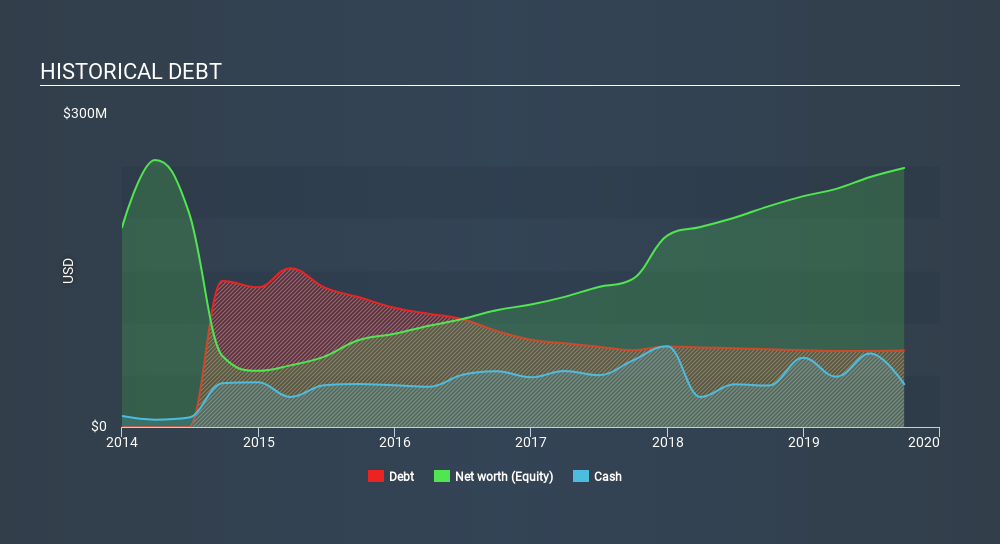- United States
- /
- Aerospace & Defense
- /
- NYSE:VVX
Here's Why Vectrus (NYSE:VEC) Can Manage Its Debt Responsibly

David Iben put it well when he said, 'Volatility is not a risk we care about. What we care about is avoiding the permanent loss of capital. When we think about how risky a company is, we always like to look at its use of debt, since debt overload can lead to ruin. We note that Vectrus, Inc. (NYSE:VEC) does have debt on its balance sheet. But should shareholders be worried about its use of debt?
What Risk Does Debt Bring?
Debt is a tool to help businesses grow, but if a business is incapable of paying off its lenders, then it exists at their mercy. Ultimately, if the company can't fulfill its legal obligations to repay debt, shareholders could walk away with nothing. However, a more usual (but still expensive) situation is where a company must dilute shareholders at a cheap share price simply to get debt under control. Of course, plenty of companies use debt to fund growth, without any negative consequences. The first thing to do when considering how much debt a business uses is to look at its cash and debt together.
Check out our latest analysis for Vectrus
What Is Vectrus's Debt?
As you can see below, at the end of September 2019, Vectrus had US$73.2m of debt, up from US$74.5 a year ago. Click the image for more detail. However, because it has a cash reserve of US$41.1m, its net debt is less, at about US$32.2m.

How Healthy Is Vectrus's Balance Sheet?
Zooming in on the latest balance sheet data, we can see that Vectrus had liabilities of US$250.7m due within 12 months and liabilities of US$136.4m due beyond that. On the other hand, it had cash of US$41.1m and US$254.8m worth of receivables due within a year. So it has liabilities totalling US$91.3m more than its cash and near-term receivables, combined.
Given Vectrus has a market capitalization of US$661.9m, it's hard to believe these liabilities pose much threat. Having said that, it's clear that we should continue to monitor its balance sheet, lest it change for the worse.
We measure a company's debt load relative to its earnings power by looking at its net debt divided by its earnings before interest, tax, depreciation, and amortization (EBITDA) and by calculating how easily its earnings before interest and tax (EBIT) cover its interest expense (interest cover). Thus we consider debt relative to earnings both with and without depreciation and amortization expenses.
With net debt sitting at just 0.56 times EBITDA, Vectrus is arguably pretty conservatively geared. And this view is supported by the solid interest coverage, with EBIT coming in at 8.3 times the interest expense over the last year. And we also note warmly that Vectrus grew its EBIT by 13% last year, making its debt load easier to handle. There's no doubt that we learn most about debt from the balance sheet. But ultimately the future profitability of the business will decide if Vectrus can strengthen its balance sheet over time. So if you want to see what the professionals think, you might find this free report on analyst profit forecasts to be interesting.
Finally, a company can only pay off debt with cold hard cash, not accounting profits. So we clearly need to look at whether that EBIT is leading to corresponding free cash flow. Over the most recent three years, Vectrus recorded free cash flow worth 57% of its EBIT, which is around normal, given free cash flow excludes interest and tax. This free cash flow puts the company in a good position to pay down debt, when appropriate.
Our View
The good news is that Vectrus's demonstrated ability handle its debt, based on its EBITDA, delights us like a fluffy puppy does a toddler. And its interest cover is good too. When we consider the range of factors above, it looks like Vectrus is pretty sensible with its use of debt. While that brings some risk, it can also enhance returns for shareholders. When analysing debt levels, the balance sheet is the obvious place to start. But ultimately, every company can contain risks that exist outside of the balance sheet. To that end, you should be aware of the 2 warning signs we've spotted with Vectrus .
When all is said and done, sometimes its easier to focus on companies that don't even need debt. Readers can access a list of growth stocks with zero net debt 100% free, right now.
If you spot an error that warrants correction, please contact the editor at editorial-team@simplywallst.com. This article by Simply Wall St is general in nature. It does not constitute a recommendation to buy or sell any stock, and does not take account of your objectives, or your financial situation. Simply Wall St has no position in the stocks mentioned.
We aim to bring you long-term focused research analysis driven by fundamental data. Note that our analysis may not factor in the latest price-sensitive company announcements or qualitative material. Thank you for reading.
About NYSE:VVX
V2X
Provides critical mission solutions and support services to defense customers worldwide.
Good value with moderate growth potential.
Similar Companies
Market Insights
Community Narratives



